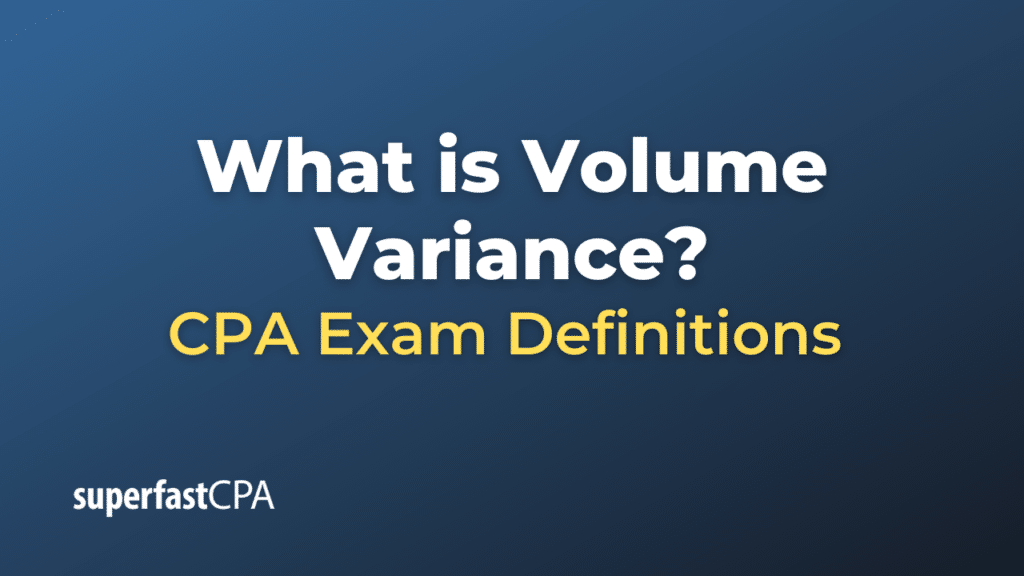Volume Variance
Volume variance is a concept used in managerial accounting to measure the difference between the actual quantity of output and the budgeted or expected quantity, typically in terms of units produced or sold. This metric helps management assess how well a company’s operations align with projections and can be especially helpful in analyzing production efficiency, sales effectiveness, and operational control.
Volume variance can be categorized into different types based on what aspect of business operations is being scrutinized:
- Sales Volume Variance: This measures the difference between the actual number of units sold and the expected number of units sold, multiplied by the budgeted unit price. It helps in understanding whether the company was able to meet its sales targets.
SalesVolumeVariance = (ActualUnitsSold − BudgetedUnitsSold) × BudgetedSellingPrice - Production Volume Variance: This is the difference between the actual number of units produced and the expected number of units produced, multiplied by the standard cost per unit. It helps identify whether a manufacturing operation was efficient in using its resources.
ProductionVolumeVariance = (ActualUnitsProduced − BudgetedUnitsProduced) × StandardCostPerUnit - Fixed Overhead Volume Variance: This measures the difference between the budgeted fixed overhead based on actual output levels and the budgeted fixed overhead based on expected output levels. This helps identify how well fixed costs were utilized.
FixedOverheadVolumeVariance = (ActualOutputLevel − BudgetedOutputLevel) × FixedOverheadRate
Why It’s Important:
- Performance Evaluation: Volume variance helps in assessing the performance of various departments, from production to sales.
- Strategic Decision-Making : Management can make informed decisions based on the variances, such as revising sales strategies or improving production processes.
- Cost Control: By identifying variances, a company can focus on areas where costs may be spiraling out of control due to lower-than-expected volumes.
- Budgetary Control: Variances can prompt a re-evaluation of budgets and targets, helping the company set more realistic goals.
By analyzing volume variances, a company can gain insights into its operational efficiency and effectiveness, allowing for timely corrective actions and better strategic planning.
Example of Volume Variance
Let’s consider a fictional example to illustrate how volume variance works. We’ll focus on a company called “CleanWave,” which produces detergent.
CleanWave’s Budgeted and Actual Data:
- Budgeted Units to be Produced: 1,000 bottles
- Actual Units Produced: 900 bottles
- Standard Cost Per Unit: $10
- Budgeted Selling Price: $20
- Actual Units Sold: 850 bottles
- Budgeted Units to be Sold: 900 bottles
Calculating Sales Volume Variance:
To calculate the sales volume variance, we use the formula:
Sales Volume Variance = (Actual Units Sold − Budgeted Units Sold) × Budgeted Selling Price
Plugging in CleanWave’s numbers:
Sales Volume Variance = (850 – 900) x $20
Sales Volume Variance = -50 x $20
Sales Volume Variance = -$1,000
A negative sales volume variance of -$1,000 suggests that CleanWave sold 50 bottles less than planned, resulting in $1,000 less revenue than expected.
Calculating Production Volume Variance:
To calculate the production volume variance, we use the formula:
Production Volume Variance = (Actual Units Produced − Budgeted Units Produced) × Standard Cost Per Unit
Plugging in CleanWave’s numbers:
Production Volume Variance = (900 – 1,000) x $10
Production Volume Variance = -100 x $10
Production Volume Variance = -$1,000
A negative production volume variance of -$1,000 indicates that CleanWave produced 100 bottles less than expected, costing the company an additional $1,000 in terms of lost production.
Analysis:
- Sales Volume Variance: CleanWave sold fewer bottles than expected, leading to lower revenue. The company should investigate why this happened. It could be due to a variety of factors, such as ineffective marketing, competition, or economic conditions.
- Production Volume Variance: The lower production volume may have contributed to the negative sales volume variance if the company was unable to meet customer demand. Alternatively, the company might have accurately anticipated lower demand but failed to adjust its production plans accordingly.
Managerial Implications:
- CleanWave’s management needs to assess why both production and sales fell short of expectations.
- Were the budgeted figures unrealistic?
- Are there inefficiencies in the production process?
- Is the sales team underperforming, or is there decreased market demand?
By analyzing these volume variances, CleanWave can make better-informed decisions on production scheduling, sales strategies, and overall operational improvements.













